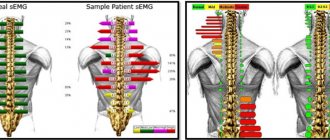Why does the belly grow? Why does the belly grow and how to deal with it?
This article is about how people's bellies grow. After reading it, you will understand what needs to be done practically at every stage of the movement from a beautiful flat stomach to a saggy, protruding belly. Sooner or later, every person notices a flabby fold of subcutaneous fat on their stomach. Gaining excess weight starts from the stomach. At some point, the balance between food energy and its consumption shifts, and excess energy begins to be stored as fat.
For those who take care of themselves, fat appears after a long break from fitness or a change in active lifestyle. In almost all men this happens after 40 years and in girls after 25.
Therefore, even if you have hard abdominal muscles, the relief of which is visible under a thin layer of subcutaneous fat, it will still be useful for you to read about how to preserve this wealth. So, it all starts with the appearance of excess belly fat. This is the first stage of livestock farming. Simultaneously with the growth of subcutaneous fat, internal fat begins to grow. This is a special fat located in the omentum and around the internal organs of the abdomen. It is brown in color in contrast to the light yellow subcutaneous fat.
Brown visceral fat is also excess weight that needs to be gotten rid of, but the most unpleasant thing is that it releases substances into the blood that stimulate fat formation and an increase in blood pressure.
Although visceral fat cannot be measured directly, studies have shown that its mass is related to waist circumference. If you have belly fat, it means there is already excess internal brown fat, which has begun its harmful activity, causing an increase in blood pressure and insulin resistance.
Many people note that if previously they could eat as much as they wanted and fat did not stick to them, then from a certain point they became very sensitive to errors in the diet and fat began to grow much faster than before.
The second stage of growing a belly begins when the fat fold on the abdomen begins to interfere with the usual physical exercises for the abdomen. It is clear that the transition to the second stage occurs in the absence of these same exercises, and the abdominal muscles become less trained. However, the abdominal muscles are not biceps; they do not require special strength. What they need is tone. It is no coincidence that they are called the muscles of the anterior abdominal wall. The tone of the abdominal muscles forms this very wall. Accordingly, if there is no tone, then the wall is more like a bag.
So, it is the extra layer of fat on the abdomen that aggravates the matter, making it difficult to maintain the tone of already relaxed abdominal muscles.
Thus, the transition to the second stage is characterized by the first manifestations of a belly, namely: a protruded belly is added to the layer of fat due to weak abdominal muscles. The belly that we see in the second stage is the internal organs, surrounded by overgrown brown fat, pressing on the weak muscles of the front wall of the abdomen, which can no longer withstand the pressure from the inside. Of course, all this is covered with a subcutaneous fat layer, which continues to grow. Finally, in the third stage of growing a belly, changes in posture are added. Weakened abdominal and back muscles can no longer maintain the same posture, stooping appears and the stomach protrudes even more. To distinguish the third stage from the second, you need to try to straighten your shoulders and pull in your stomach. If you manage to do this and hold it for at least half a minute, then the third stage has not yet been reached.
It must be said that the three stages of animal husbandry described are typical for men. In women, already at the beginning of the second stage, along with belly fat, fat on the hips and buttocks begins to grow, which worries women much more, as it is accompanied by cellulite and the need to change their wardrobe.
At the same time, the second and third stages in women develop much later. I can reassure you that from the point of view of harm to health, this type of obesity (gynoid) is much less dangerous than abdominal obesity, although, of course, it is also unpleasant for girls. So, what should you do to slow down, or even better, stop your movement from a flat stomach to a bulging belly. The easiest way to act is in the first stage, when there is still sufficient muscle tone in the abdominal wall. Here it is enough to pay attention in time to the growth of the layer of fat on the abdomen and resume your usual exercises, or start them if you have never done them, because the time has come.
By the way, if you got a beautiful belly without any effort on your part, then you still need to know that when you need these efforts, they should have two directions. The first is burning fat through aerobic exercise and the second is strengthening the abdominal muscles. Aerobic exercise is when your heart rate is around 70% of your maximum.
The optimal heart rate for aerobic exercise is calculated by age or determined individually using heart monitors. If you exceed this frequency, you can enter anaerobic mode. In this mode, speed and power loads are provided with energy due to the breakdown of creatine lactic acid, and not at all by the breakdown of fat.
The duration of aerobic exercise should be at least 40 minutes. The fact is that energy reserves in the form of liver glycogen are enough for 20 minutes of aerobic exercise, after which the energy obtained from accumulated fat begins to gradually be activated. The process of fat breakdown reaches its maximum activation only after 40 minutes of aerobic exercise.
You need to use special tools to monitor your progress in fat loss; scales alone are not enough. Simply because even aerobic exercise will cause an increase in muscle mass, which (even if small), due to the greater specific gravity of muscles, will mask the real decrease in fat mass when weighed.
To get an objective picture of fat loss, use electronic butyrometers or a caliper. Electronic devices pass a small current through the arms or legs and, based on the difference in resistance of fat and non-fat tissue, determine their approximate ratio. They must be used under identical conditions and not consume liquids before measurement. The caliper measures the thickness of the skin fold, allowing you to determine the fat content using the accompanying table. If you have already reached the second stage, and feel that it has become difficult or even impossible to perform the usual exercises to strengthen the abdominal wall, then start with aerobic exercises to reduce the layer of belly fat and gradually include exercises for the abdominal muscles, but in a gentle or lightweight version.
And finally, in the third stage, when the loss of abdominal muscle tone is already affecting your posture, do everything as in the second stage, but add posture exercises and monitor your posture throughout the day.
Why do your sides and stomach grow when you gain muscle mass?
Only with us: Enter promotional code bonus2020 in the coupon field when placing an order before March 31, 2020 and receive a 25% discount on everything!
Are you gaining weight and your belly is growing along with it? Find out the reasons why your belly grows when you gain weight. Eliminate all errors!
An increase in waist size can occur as a result of:
- Growth of belly fat
- Decreased muscle tone
Let's take a closer look at these reasons.
Why does belly fat grow?
It’s not just the consumption of unhealthy foods that contributes to the formation of fat cells in the abdominal area.
Sometimes grueling workouts in the gym and a strict diet do not help get rid of fat deposits in the abdominal area.
An increase in waist size is also observed with:
- Insufficient physical activity. It is the “sofa” lifestyle that leads to the formation of a fat layer not only on the stomach, but also on the sides, arms, buttocks and thighs.
- Stress. Overexertion stimulates the production of cortisol in the body, due to which excess sugar begins to be released from the liver. As a result, a person begins to experience a feeling of hunger, which constantly eats.
- Health problems. Belly fat is formed not only due to poor nutrition, but also due to hormonal imbalance, heart and vascular diseases.
According to research by nutritionists, the tendency to gain excess weight can also be “inherited.”
Simple carbohydrates in the diet
The main source of energy in food is carbohydrates . It is almost impossible to remove them from the diet, since they are found in almost all foods, including vegetables and fruits.
But in the fight against fat, you cannot completely exclude the source of energy from your diet. You just need to introduce the “correct” carbohydrates into the menu, which are not deposited on the waist, but, on the contrary, reduce its size.
The main source of energy in food is carbohydrates
There are 2 types of carbohydrates:
- Complex (slow);
- Simple (fast).
The way of eating when fighting excess fat involves excluding fast (simple) carbohydrates from your diet.
They are contained in:
- potatoes:
- bananas;
- sugar;
- dates;
- carbonated drinks;
- pasta;
- grapes;
- flour products;
- baking.
When these foods are consumed, insulin production rises and falls sharply, thereby provoking hunger.
Slow (complex) carbohydrates “work” according to a different principle.
Once in the body, they slowly break down and thereby prevent sugar from rising sharply. As a result, the feeling of hunger appears much later, and a person consumes significantly fewer calories during the day.
The way of eating when fighting excess fat involves excluding fast (simple) carbohydrates from your diet.
Complex carbohydrates include:
- nuts;
- berries;
- legumes;
- vegetables;
- durum pasta;
- whole wheat bread.
To prevent the foods you eat from turning into fat on your stomach, you must adhere to a 1:3 ratio when eating, where one serving is simple carbohydrates and three are complex.
Consumption of animal fats
Frequent consumption of animal fats in food can lead to an increase in the size of the abdomen, as well as provoke problems in the cardiovascular system and increase cholesterol levels.
Dangerous products in this category include:
- salo;
- fatty cheese;
- butter;
- pork.
You can replace dangerous fats with products that contain less fat.
These include:
- poultry meat;
- reduced fat dairy products;
- eggs;
- beef;
- low-fat fish;
- rabbit meat;
- seafood.
When fighting excess weight around the waist, it is important to understand that you should not completely exclude fats from your diet, since they contribute to the proper absorption of vitamins and normalize the production of hormones.
Salty food
In the fight against extra pounds, nutritionists advise giving up salt. Of course, this product does not increase the overall calorie content of dishes, but it promotes fluid retention, which leads to a slowdown in metabolic processes in the body.
Nutritionists advise giving up salt in the fight against extra pounds.
As a result, the belly either does not disappear, or goes away, but very slowly. For people who find it difficult to eliminate salt from their diet, experts advise adding the spice not during the cooking process, but before serving it.
Fried foods
Heat treatment of products in butter or vegetable oil significantly increases the calorie content of the dish, thereby adding kilograms.
To get a waistline you will have to give up fried foods and prepare food in other ways. For example, steamed, using a grill or in the oven.
Caffeine for the athlete
Two questions that have intrigued sports scientists for 25 years: Does caffeine consumed before exercise really cause increased performance, and if so, what mechanisms are responsible for this improvement?
Studies have shown that consuming caffeine increases the time spent in endurance exercise, causing a metabolic effect in the human body. The reason for this was thought to be the presence of caffeine in the blood, which seemed to stimulate the release of epinephrine catecholamines and norepinephrine, which leads to the use of fat as fuel to work muscles.
Another possible implication of caffeine's effects is that it leads to stronger muscle contractions, for example, by affecting the calcium in the muscles, which is necessary for further work, is reduced due to the large amount of caffeine.
Some studies have shown that caffeine does improve performance in the short term, although the results were not always significant. If a muscle wants to change performance, then in such exercises caffeine must act on it or on the central nervous system.
A group of sports science students took part in an experiment that tested whether caffeine actually affects performance.
Source: https://sportpit68.ru/trenirovki/zhivot-bodibildera.html
When the belly starts to grow. How quickly does the fertilized egg enlarge?
You can understand the issue by knowing how quickly the size of the fertilized egg changes, and how the process affects the woman’s external condition.
The reproductive organs are located in the pelvic area, located in the lower abdomen, and are reliably protected by the pelvic bones. The uterus is located between the bladder and rectum directly in the central part of the pelvis.
Externally, the uterus resembles a pear, with its narrow part facing down. The organ is quite elastic, capable of significantly stretching during pregnancy, and also quickly contracting after childbirth.
In nulliparous women, the uterus weighs approximately 50 g and does not protrude above the pubic bone. In women who have given birth, the organ is slightly enlarged in size, and its weight is 80-100 g.
The uterus grows as pregnancy progresses.
After 8-10 days from the moment of sexual intercourse, the fertilized egg is implanted into the wall of the organ. The process of penetration into the endometrium takes about 2 days. As the embryo grows, the size of the uterus changes:
- up to 4 weeks, the size of the fertilized egg does not exceed 4 mm;
- at 5 weeks the size increases to 6 mm;
- at 6 weeks – 11-18 mm;
- at 8 weeks – 27-34 mm;
- at 10 weeks –50 mm.
Every day the diameter of the egg increases by approximately 1 mm until 15-16 weeks. At this time, the CTE of the fetus averages 8-9 cm, and its weight is 85 g.
After this period, the growth rate accelerates, the daily increase in diameter is 2-2.5 mm. It is at this time that the tummy most often begins to protrude.
However, it is not necessary that the belly will begin to grow after the 16th week, since the course of the process depends on many factors. Sometimes pregnancy proceeds “secretly” and becomes noticeable at 7-9 months.
Sometimes a woman already notices in the first month that her stomach has begun to enlarge.
Why does the belly grow? Why does the belly begin to grow after childbirth?
The postpartum period is dangerous for the stomach for two reasons:
- During pregnancy, the walls of the abdomen stretch and in most cases it is difficult to return to their original place. If the diet is unbalanced, the abdominal cavity quickly becomes overgrown with fat. At the same time, it is not very important how much a young mother eats - her metabolism is still tuned to maximum absorption of nutrients.
- Lack of sleep leads to overeating - this is a scientific fact. The body compensates for the stress of lack of sleep with enhanced nutrition.
What to do?
- Special exercises for retracting the abdomen will help, but fitness trainers recommend using them only 6 months after the birth of the child. Unfortunately, by this time you can already acquire a solid tummy.
- If the mother does not breastfeed, it is not difficult to create the right diet. But a nursing woman is quite limited in her choice of products.
- Sleep all your free time. Yes, it's difficult, but no one benefits from an unhappy and tired mom.
- Devote your free time from sleep to walks and physical activity.
Hair grows on the stomach. Why can a girl grow hair on her stomach?
Causes of belly hair
Hirsutism is a disease in which women begin to grow hair in a male pattern. This is not white fluff, the hair is dark, coarse and long. The appearance of this disease is a consequence of other problems in the body, for example, an excess of produced male hormones. Treatment is prescribed only by an endocrinologist and will not eliminate the appearance of new hair, but will only slow down its growth. Under no circumstances should you self-medicate, as this can lead to serious hormonal imbalances in the body. Another reason for the appearance of belly hair in girls may be a genetic predisposition. Brunettes and girls of Eastern nationalities are most often prone to this problem. The only way to deal with hair is to remove it. Unwanted hair can also appear during pregnancy. This is due to changes in a woman's hormonal levels due to excess progesterone, which helps keep the fetus in the uterus, preventing its rejection, and helps the uterus prepare for childbirth.
Removing unwanted hair
Determining calorie needs
Before you begin directly drawing up a nutrition plan, you need to determine your daily calorie needs. This is the number of calories that you need to eat so that your current weight remains unchanged. You can calculate this value using special online calculators. After the program receives information about your height, weight, age, gender and physical activity level, it calculates the approximate number of calories needed to maintain the specified weight.
However, calorie counting tools are just a starting point. Depending on the scale readings, some adjustments will need to be made periodically.
However, we advise you not to pay attention to changes in weight during the first 2 weeks. Increased calorie intake can cause additional water retention in the body. This weight gain is not due to fat and should not be a reason for immediate dietary changes at the very beginning of the diet.
After a couple of weeks, you can adjust anything if necessary.
When your belly starts to grow. How the belly grows during pregnancy
The most important reproductive organ of the female body is the uterus. The enlargement of this organ is primarily associated with the development of the embryo.
In the classic course of pregnancy, the uterus should significantly exceed its pre-pregnancy weight (approximately 10 times), increase in size, a denser vascular network should develop in it, and amniotic fluid should appear.
Oxygen is supplied to the embryo through the blood; if the belly is small, then the fetus does not have enough oxygen, it begins to experience hypoxia (oxygen starvation), this condition is dangerous for the embryo.
If the tendency for an enlarged abdomen is not within the normal range, this may indicate abnormal amounts of amniotic fluid and sometimes even an ectopic pregnancy.
An ectopic pregnancy is very dangerous for a woman’s life. Such a pregnancy, as a rule, does not lead to the formation of a fetus.
In this pregnancy, the fetus begins to develop outside the uterus, often in the fallopian tubes. The reason may be that the egg did not come out of the tube and did not attach to the placenta.
An important indicator of an ectopic pregnancy is that in this case the size of the woman’s abdomen increases, not corresponding to normal values. Therefore, in the presence of an ectopic pregnancy, an abortion is usually performed.
My belly is growing. Nerves, stress and wine
- The work is sedentary, colleagues often bring treats from home, pies and pies are not transferred to the home table. And where do these same pies go later, pray tell? We drove home from work by car, that is, without particularly straining. This is just a family dinner. We sat, ate, and then went to the side. It's early to get up tomorrow. So the eaten pies and other harmful things remained inside you, and successfully turned into fat deposits, first on the stomach, then on the buttocks and thighs, etc.
- Admit it: do you smoke? Only honestly! Do you drink beer or wine on weekends? If the answer is yes, and your stomach is literally protruding, throw away this cigarette and introduce a personal prohibition law. Nicotine and alcohol, when regularly introduced into the body, disrupt metabolism. So fat is deposited in our problem areas, including on the stomach.
- If you just recently “visited” the maternity hospital and your stomach is just a “relic” of a recent birth, then this is a fixable matter. Especially if you regularly went to the gym before pregnancy. If you have never been an athlete, but you really want a flat tummy, then you need to make an effort. Do yoga, hula hoop at home, and after a while, all the excess in the waist area will gradually burn away under the pressure of exercise.
- Endless stress, without which, unfortunately, our life is unthinkable, can add another big and noticeable stress to you - a bulging belly. Try to think positively, even if you were deprived of a bonus at work or your child brought back a two- or three-grade diary from school. Don’t worry too much, otherwise an ugly “bundle of nerves” will grow instead of a toned, slender tummy.
- Are you always unable to get enough sleep, like wet salt from a salt shaker? Every day you promise yourself to go to bed early, but work and watching your favorite TV series do not allow you to keep your promise. How familiar, right? So, you will be surprised, but lack of sleep, as well as “oversleeping,” lead to weight gain and, in particular, a rounding of the abdomen. Try to follow the ideal regime for at least a couple of weeks. Go to bed at 22:00, get up at 6:00. You'll see, your body will thank you. Your stomach will deflate a little, and you will feel much better.
- Play, hormone, but don’t play around. It’s a pity, but we are not able to give such an order to our hormones. Imbalances can happen unexpectedly. There are many reasons for such failures, sometimes they can only be calculated after lengthy examinations. But the consequence is immediately obvious - severe obesity and other serious health problems. In such a situation, an unsightly belly can be removed only by restoring normal hormonal levels. Note, hormones that require special attention: adrenaline, estrogen, thyroxine, cortisol, insulin, triiodothyronine. Our female well-being and even weight often depend on their level.
- “Girl, sit down, you’re pregnant,” the young man on the bus tells you, giving up his seat. And you are not pregnant at all. It’s just winter, so we relaxed and saved up fat for the cold weather. Of course, blaming the time of year is not entirely correct. As such, winter is not to blame for anything, it’s just that with its arrival we all go into “sleep mode”. I don’t feel like training in the gym; summer and beach season are still a long way off. Sometimes you can rob the refrigerator at night. Again, the autumn-winter depression has arrived. Do you recognize yourself? Same thing.
- Team "Gases!" Alas, the belly often grows precisely in response to this command. Increased flatulence sometimes causes the stomach to swell like a ball. Hush, Tanechka (Yulia, Mashenka, Irina), don’t cry, we’ll blow away the stupid ball! To do this, we do not eat dry food, follow a diet and monitor which foods could provoke the accumulation of excess gas in the intestines.
- Gynecology. Unfortunately, a purely female, but very dangerous cause of abdominal growth is often benign and malignant neoplasms of the uterus and ovaries. At the same time, it is the lower abdomen that suffers, tenses, and swells. This bloating is usually accompanied by menstrual irregularities, the appearance of “unscheduled” bleeding, frequent urination and a constant feeling of indigestion.
- If you have decidedly rejected all of the above reasons, go for an ultrasound of the abdominal cavity. Perhaps it's all about the accumulation of fluid in the abdominal cavity. Otherwise, this is called ascites, and, sadly, it does not come alone. It is just an accompaniment of many serious diseases: cancer, cirrhosis of the liver, acute heart failure.
Bodybuilding and Bodybuilding for professionals
| News |
The article could begin and end with just one sentence-answer: sport, sport and sport again. However, there are many nuances that, all other things being equal, will ensure the fastest progress towards the goal - a beautiful and trained belly. First of all, we should highlight two main components of the abdominal shape: the muscles of the abdominal wall and the fat layer. So, for muscle tissue, regular strength training will not be superfluous, and for fat tissue, proper organic nutrition with a slight calorie deficit and aerobic exercise. So, what can you do on the way to a beautiful and strong stomach: Home workouts Regular home workouts will help tone your abdominal muscles and mentally prepare for more serious loads in the gym. Simply put, “pump up your abs.” In this case, it is best to do several sets of 25-30 repetitions before breakfast. Such short workouts will not only invigorate you well, but also activate your metabolism, and also force the body to use internal reserves, that is, start burning fat deposits. Moreover, it will be the areas of the fat layer that will be affected that are located above the loaded muscles - the abdominal muscles. Visiting the gym The gym will not only bring your abdominal muscles to the desired shape, it will also make your daily routine more structured and teach you how to achieve your goals. After all, it has long been noted that regular exercise develops strong-willed qualities. When you first start visiting the gym, it is recommended to hire a professional trainer who will prepare an individual program, monitor progress and adjust the progress of the exercises. Maintaining moderation in food This point does not at all mean performing exhausting diets. It will be enough to simply learn to listen to your body. I can only advise one thing: if you want something, you shouldn’t deny yourself it. The body itself will tell you how much and in what quantities certain products should be consumed. The main thing is to observe its signals and interpret them correctly. If you really need to go on a diet, you should definitely contact a nutritionist. Only he can give competent recommendations in relation to each specific case. Reducing the number of stressful situations To successfully combat fat deposits in the abdominal area, forget about stress. Learn to control your emotions, even if this means taking up meditative practices. After all, it has long been known that in stressful situations, a large amount of the hormone cortisone is produced, which, in combination with adrenaline, promotes the growth of adipose tissue in the abdominal region. Getting rid of bad habits Bad habits should also be left behind. And not only because they cause direct harm to the body. First of all, they deprive you of your will. So, without being able to cope with smoking, it is unlikely that you can successfully continue going to the gym. In fact, all the recommendations come down to the development of strong-willed qualities and regular, daily work on your body and spirit. After all, only by working on the physical and spiritual components at the same time can a person achieve successful results that will stay with him for a long time. The problem of an unsightly belly is no exception. So, if you want the word “belly” to cause you not a bad mood, but joy and self-enjoyment, be patient and start moving towards your goal right now. Source
The belly grows from beer. Why does a beer belly appear?
A beer belly is typical specifically for men due to the peculiarities of fat accumulation in the body: in men, fat reserves are deposited mainly in the waist area. In addition, alcohol changes male hormonal levels, which also promotes fat accumulation.
Let's look at the reasons why beer increases body fat.
Beer has a lot of calories
Beer contains from 43 to 45 kilocalories per 100 grams of drink. When you consider how much beer his loyal fans are able to drink in an evening, the numbers are frightening.
One bottle of beer contains about 215 kilocalories, one liter - 430, and two liters - 860. This is about a third of the daily calorie intake for a young man leading a sedentary or moderately active lifestyle. Add to this the usual food during the day and a beer snack, which is also often quite high in calories, and you will get a huge excess of calories.
Alcohol is processed first, then everything else
Ethyl alcohol contains about seven kilocalories per gram. Since alcohol is toxic to the body, the body tries to process these calories first, and the carbohydrates and fats that come with alcohol are stored as fat reserves. Of course, if you don't have time to spend them.
Until the body processes these “empty” calories, the rest will be stored as fat.
Beer changes hormonal levels
According to the results of the 2004 study Effect of moderate alcohol consumption on plasma dehydroepiandrosterone sulfate, testosterone, and estradiol levels in middle-aged men and postmenopausal women: a diet-controlled intervention study, daily beer consumption for six weeks reduces testosterone levels in men by 11 .7%.
Testosterone is a male sex hormone that helps burn fat and build muscle mass.
One old study, Sex hormones and adrenocortical steroids in men acutely intoxicated with ethanol, confirms that testosterone remains low for 24 hours after drinking large doses of alcohol.
A 1998 study of Alcoholic beverages as a source of estrogens found that beer contains the phytoestrogens daidzein and genistein, which also suppress testosterone production.
Decreased testosterone directly affects fat and muscle content. Fat burning slows down, as does muscle building. The less muscle there is, the fewer calories are spent on maintaining it and, again, the slower the fat loss.
Alcohol increases calorie intake
The 2001 Stimulation of Appetite by Alcohol study found that consuming alcohol before dinner increases overall caloric intake. After 330 milliliters of alcoholic beer, study participants consumed an average of 1,744 kilocalories, after non-alcoholic beer - 1,548 kilocalories, and without beer at all - 1,521 kilocalories. Taking into account the calorie content of alcohol, the caloric intake of people who drank beer increased by 30% compared to those who did not drink beer.
Beer belly appears from a combination of two factors: excess calories and the effect of alcohol on hormonal levels.
We've sorted out the reasons, let's move on to methods of struggle.
Why does your belly start to grow even when you are at normal weight?
Excess belly fat is unsightly and unhealthy: it is a risk factor for metabolic syndrome, type 2 diabetes, heart disease and cancer. Unhealthy belly fat is called visceral fat, which accumulates around the liver and other abdominal organs.
Even people of normal weight who have excess belly fat are at risk for health problems. To prevent this, we will tell you why the belly grows and how to remove excess fat deposits in the abdominal area.
Why the belly grows: possible reasons
Sometimes, when we gain weight, we ourselves can determine the reason for the increase in kilograms - a decrease in physical activity and/or overeating.
As a rule, to get rid of excess weight, it is enough to adjust your diet and increase your calorie consumption during active pastime.
However, sometimes the reason for weight gain is not so obvious, and fat accumulates in certain areas of the body, for example, in the abdominal area.
To determine why your belly is growing, you need to pay attention to the following factors:
- nutritional features;
- beverages;
- level of physical activity;
- hormonal background;
- intestinal microflora.
Some diseases also lead to weight gain, so it would be a good idea to consult a doctor to rule out this factor.
What foods can lead to an increase in visceral fat?
You eat more sugar every day than you think. It is almost impossible to control its amount in food, and sugar can be found in sauces and fried foods. Research has found a link between high sugar intake and belly fat.
- Try to reduce the amount of sugar and trans fats in your diet so that less fat is deposited in the abdominal area.
Trans fats are the most harmful of all, since their stability is achieved by saturating them with hydrogen (hydrogenation).
And such fats are used to extend the shelf life of various products, for example, crackers, muffins, and baking mixes.
Trans fats have been proven to trigger inflammation and can lead to insulin resistance, heart disease and other diseases. It is not surprising that the belly of such substances grows in both men and women.
A sufficient amount of protein in the diet is very important, since protein is not only the main building material for the body and is not stored in reserve, but also helps control hunger and speed up metabolism. Lack of protein in the long term leads to weight gain and belly growth due to increased levels of a hormone called neuropeptide Y.
To control weight, you also need to eat enough fiber - it fills you up, stabilizes hunger hormones and allows you to eat less high-calorie foods. If the diet is dominated by carbohydrates and lacks fiber, a person unsuccessfully tries to fight the feeling of hunger and gains weight.
What drinks cause belly fat deposition?
The first and most important liquid enemy of a flat stomach is alcohol. Firstly, it contains too much sugar, which itself promotes fat accumulation. Second, liquid calories do not affect appetite in the same way as solid foods.
If you drink calories, you don't get full, so you add food on top. And, as a rule, this food is quite high in calories and harmful. In addition, alcohol promotes inflammation, liver disease and other health problems and, as studies show, suppresses calorie burning and promotes fat storage.
This explains why the belly grows and also why it is called a beer belly.
Sweet soda has long been rightfully accused of causing weight gain because it contains huge doses of sugar. However, fruit juices are also not the best drink for those who want to protect their belly from excess fat, since even unsweetened 100% fruit juice contains a lot of sugar. If you compare 250 ml of juice and the same amount of cola, they will contain the same amount of sugar - 24 grams.
How does physical activity level affect belly fat?
A sedentary lifestyle is one of the most significant risk factors for poor health. The decline in human activity levels has been observed for several decades. The study, which was conducted from 1988 to 2010 in the United States, showed that with a decrease in physical activity, weight gain, including an increase in abdominal girth, increased in men and women.
- Physical activity will not only help prevent the accumulation of belly fat, but also improve your overall health.
But the harm of inactivity doesn’t stop there. Research also shows that people who have lost belly fat gain the weight back when they become more inactive.
What hormonal changes can lead to belly growth?
During the menopausal period, women often wonder why their belly grows.
The fact is that during puberty, the hormone estrogen causes the body to accumulate fat in the thighs and buttocks - this is how a woman prepares for a potential pregnancy.
Menopause occurs after menstruation stops, and during this time estrogen levels drop sharply, causing fat to be deposited in the abdominal area.
Another hormone, elevated levels of which can cause belly fat to grow, is cortisol. This hormone is produced by the adrenal glands in stressful situations, but constant stress leads to the appearance of a “cortisol belly.” Lack of sleep also increases cortisol levels and causes weight gain.
How does intestinal microflora affect fat accumulation?
The human intestine is home to various bacteria. Some of them benefit the body, others harm it. An imbalance of bacteria in the gut increases the risk of developing type 2 diabetes, heart disease, cancer and other diseases.
Some studies show that the prevalence of harmful bacteria leads to weight gain, including in the abdominal area. Scientists have found large numbers of Firmicutes bacteria in obese people and hypothesized that such bacteria increase the amount of calories absorbed from food.
There can be many answers to the question of why your belly is growing: poor eating habits, lack of sleep, hormonal changes, lack of physical activity, imbalance of bacteria in the intestines, frequent stress and even diseases.
In some cases, the belly grows due to the influence of several of the above factors.
Therefore, we believe that the approach to getting rid of belly fat should be comprehensive - the right lifestyle will allow you to stay slim for many years!
Source: estet-portal.com
Source: https://fithacker.ru/articles/pochemu-nachinaet-rasti-zhivot-dazhe-kogda-u-tebya-normalnyiy-ves/
Poor posture as a cause of abdominal enlargement
If there is absolutely no excess weight, a woman may have a protruding belly, which does not add beauty to her overall appearance. Constant slouching leads to curvature of the spine, as a result of which organs in the abdominal cavity can be displaced.
The stomach grows in women - the reasons for this may lie in incorrect posture: at the initial stage, stooping leads to overstrain of the back muscles, as a result of which the abdominal muscles are overstretched. This phenomenon is typical for people leading a sedentary lifestyle and doing sedentary work.
Incorrect posture is one of the reasons why the belly grows in women.
In this case, the abdomen will increase involuntarily, and in the absence of proper physical activity, fat will accumulate in the abdominal area quite quickly.
Is your belly growing? Look for the reason! Bookmark 8
This is not pregnancy, there is no critical weight gain, but the jeans can barely fasten at the waist. What is happening, women ask themselves, seeing no particular reason for this state of affairs. Why do women’s bellies grow and often neither diet nor grueling workouts help reduce waist size and remove this hated “tummy”? In fact, there is no clear answer to this question; in each individual case, different reasons are involved, but there are a number of factors that are worth paying attention to in the fight for harmony.
Excess fat deposits in the abdominal area consist, as a rule, of internal (visceral) fat; our internal organs are clothed in this fat and it is because of it that the abdomen takes on an enlarged shape. Excessive deposits of internal fat threaten the appearance of heart disease, the development of type 2 diabetes and the occurrence of oncology. If standard methods of combating excess weight, such as diet and exercise, do not bring results, the essence of the problem lies in physiology, more precisely in hormonal levels, age-related changes, genetics or the presence of certain diseases of internal organs.
Why the belly grows in women: age-related changes
With age, the rhythm of fat accumulation and breakdown in our body changes. Metabolic rate decreases, this happens in both men and women. In women, this is also accompanied by problems that arise during menopause. Women should first of all look for the answer to the question of why the belly grows after fifty in the office of an endocrinologist and gynecologist. During menopause, the level of production of the hormones estrogen and progesterone decreases significantly, and testosterone levels also decrease, although at a less accelerated pace. These hormonal changes cause weight gain in the abdominal area. And that's bad news. The good news is that you can fight this.
Irritable bowel syndrome
Intestinal dysfunction can also lead to an enlarged belly. This condition is accompanied by constant bloating, which is often accompanied by pain, constipation or bouts of diarrhea. Intestinal dysfunction does not mean any pathology of the intestinal tract, it only means that the digestive system is not working properly. In principle, intestinal tissues are hypersensitive, so there is nothing extraordinary in the appearance of such symptoms.
Bloating is one of the most annoying side effects of irritable bowel syndrome. It is bloating that many women mistake for weight gain, since the usual clothing size in this condition turns out to be too small. It is noteworthy that towards evening the symptoms of bloating intensify and this often results in stress for those who have a period of social activity at this time of day.
To prevent bloating, it is recommended to reduce the consumption of cereal fiber. Eliminate oatmeal, muesli, and cereal bars. White bread, butter bars and cookies, in principle, can be left. Probiotics also help reduce symptoms, drink natural yoghurt, or, after consulting with your doctor, take a course of acidophilus medications. In some cases, antispastic drugs, laxatives, or drugs with the opposite effect are prescribed.
Flatulence
If you notice frequent accumulation and release of gas, but there are no other alarming symptoms, flatulence may be the cause of abdominal growth. In general, there is nothing wrong with emitting gases; often a person does not even notice it, but often increased gas formation causes a feeling of discomfort and interferes with a full life. In such cases, it is recommended to limit the consumption of non-absorbable carbohydrates, in particular beans and pulses, as well as cabbage, broccoli, apples and prunes. A well-known sugar substitute, sorbitol, can also cause increased gas formation. Try to eat slowly, chewing your food well. Poorly digested food increases the risk of gas formation. In some cases, flatulence can be a symptom of certain diseases; you should not try to make a diagnosis yourself; it is better to entrust this matter to a specialist.
Celiac disease or enteropathy
Symptoms of enteropathy may include fatigue, weight loss but a protruding belly, and abdominal pain. Celiac disease is a type of food allergy that is caused by the insufficient breakdown of grain proteins, those found in wheat and other foods ranging from pasta, bread and baked goods to sauces and gravies.
Enteropathy refers to an autoimmune disease that causes damage to the small intestine, which in turn affects its ability to absorb nutrients from food. Typically, celiac disease is diagnosed in childhood, but in some cases the diagnosis is made in adulthood. If the above symptoms are present, as well as frequent bloating and increased gas formation, it is recommended to take a blood test for enteropathy.
Why the belly grows in women: hormonal fluctuations
Changes in hormone levels are observed during the premenstrual period or early stages of pregnancy. At this time, intestinal motility slows down, more time is spent digesting food and this increases the likelihood of bloating and constipation. Light physical activity and walks in the fresh air help to speed up the digestive system, and to avoid constipation, it is recommended to drink more fluids, eat more fruits, vegetables and whole grain products.
Ovarian cancer
Frequent bloating, a constant feeling of a full stomach, as well as pain in the lower abdomen may indicate cancer of the reproductive system, in particular ovarian cancer. Often the symptoms of ovarian tumors do not cause concern, and this makes diagnosis much more difficult. Due to its mild symptoms, ovarian cancer is often diagnosed at stages that require serious treatment or surgery. If you notice that your belly is growing for no apparent reason, and you constantly feel bloating and heaviness in the lower abdomen, as well as pain when eating and urinating, consult a doctor immediately. The earlier a tumor is detected, the easier it is to get rid of it.
Wrong training program
Daily jogging and new-fangled fitness practices may be good for the heart muscle, but cardio training is not particularly helpful in reducing waist and abdominal size. The secret to effective training lies in a balanced combination of weight training and cardiovascular exercise. Strength training helps build muscle mass and therefore burn more fat. It is recommended to spend 250 minutes of moderate-intensity exercise and 125 minutes of vigorous-intensity exercise per week. Of course, training has a positive effect only in cases where abdominal enlargement is not caused by any disease.
Wrong diet
Changes in the shape of the abdomen can be caused by an unhealthy diet; large amounts of refined grains in the form of white bread, crackers, chips, carbonated drinks and desserts provoke inflammation of the gastrointestinal tract and significantly inhibit the process of losing weight in the abdominal area.
The vast majority of women dream of a beautiful, flat stomach, and despite the difficulties that await many on the path to a slim and toned figure, any of us can achieve positive results.
Jun 4, 2020Olga
Why does the belly grow during menopause and what to do? During menopause, the belly grows
- Hereditary predisposition. Many women tend to be overweight due to genetic factors. Nature already presets the amount of calories that the body can process, and the excess will be unevenly distributed throughout the adipose tissue.
- Hormonal changes. More than half of women who have entered menopause will experience an increase in their abdomen in the next 6 months. Many people wonder why this happens and what it is connected with. This is due to the fact that androgens cannot quickly turn into estrogens. Most of the androgens will dissolve in fat cells, and the lack of estrogens, which are needed to quickly absorb male sex hormones, increases the size of the belly. In addition, sudden surges of estrogen can retain fluid inside the body, resulting in persistent gas formation, which causes bloating.
- Inconsistency between fat and muscle mass. An increase in abdominal volume is associated with an age-related decrease in muscle mass. During menopause, regenerative processes will slow down, muscle tissue will recover more slowly, and a layer of fat will grow instead of muscles.
- Metabolism failure. During menopause, due to hormonal imbalance, changes occur in the functioning of the endocrine system, and disturbances in natural metabolic processes are observed. Due to a lack of hormones, the thyroid gland is unable to cope with the regulation and distribution of nutrients within the body. Therefore, food masses are absorbed more slowly and converted into fat.
- Weakening of muscle tissue. The abdomen and its stretched muscles after pregnancy support collagen, which is responsible for muscle tone. Before menopause, its production decreases.
Conclusions: how to resist rapid weight gain
To summarize, you need to make a few conclusions for yourself that will help any girl stay young and beautiful longer.
- To avoid health problems, you need to regularly visit a doctor, undergo examinations and take tests.
- An active lifestyle helps to regulate your own weight. If you can't exercise, just walk more, dance, swim, and do whatever you enjoy or can do. The main thing is not to sit still.
- With age, even those who previously had no tendency to be overweight can become obese. Therefore, watch your diet, eat properly and balanced.
- Thoughtlessly taking medications is far from the best solution. Even if your doctor prescribed the pills to you, but you notice unpleasant symptoms, you should stop taking them and consult a specialist to adjust your treatment.
- Pregnant women often gain excessive weight due to unusual desires due to hormonal levels. You cannot get carried away with eating junk food during this period; in addition to deteriorating your appearance, it is also harmful to the child’s health.
I would like to add that stress, depression, shocks, breakdowns, and other problems of a psychological nature, which also cause excess kilograms, can be overcome if desired. Moreover, the methods of struggle are often identical to the fight against excess weight - sports, an active lifestyle, a positive attitude, communication with loved ones and like-minded people.
Why does the belly grow in thin men? Why and why the belly grows in men
- deposition of subcutaneous and internal fats – a small layer of fat promotes the growth of abdominal or internal fat located in the omentum in men. Modern doctors claim that this fat is harmful to health. To process it, the liver consumes less insulin. This is what contributes to his rise in the CS. A significant concentration of insulin causes the heart to beat rapidly;
- beer syndrome - with this etiology, a man has a large belly, which is associated with the appearance of a large amount of under-oxidized foods and worms in it. Helminths help digest foods that enzymes cannot handle. Moreover, the latter components are not able to work in an acidic environment. Scientists have proven why beer belly appears. It has more to do with the state of the beer you drink. The drink is often consumed cold, which contributes to the rotting of those foods that the man ate with beer;
- oxygen deficiency - the process of energy formation is associated with the supply of oxygen and respiration. When acid-forming products are constantly supplied to the gastrointestinal tract in large quantities, the amount of calcium in the CS increases. Against the background of such a clinic, men’s pH increases and the oxygen saturation of hemoglobin decreases. The less it enters the body, the more the body’s ability to oxidize the contents of the abdomen is reduced. If men have a small belly, which is not able to cope with the supply of energy to the body, then it increases;
- weak muscles in the abdominal area - if the stomach is large, the muscles atrophy and stretch. The muscles in this area are divided into 3 groups, including the rectus, internal and external oblique muscles. The weakness of these muscles determines the shape of the growing belly. With beer syndrome, the rectus muscles weaken, and drivers develop a “labor callus” that hangs unattractively from the sides. In this case, the oblique muscles weaken, since the drivers are positioned in the seat so that these muscles are completely relaxed. With age they atrophy;
- low testosterone production – common reasons why men develop belly fat at the age of 40 are related to testosterone. It is this hormone that affects the quality of life.
Why does the belly grow in old age?
Very often, women's belly begins to grow only because their figure belongs to the so-called male type. At the same time, such ladies still remain feminine and attractive, but their fat accumulates most often, like men, in the abdominal area. In representatives of the fair sex with a female body type, fat is distributed throughout the body, accumulating most of all in the hips and back (below the shoulder blades). If it is for this reason that a woman’s belly begins to grow, nothing can be done about it. The only way to reduce the amount of fat deposits in the body is through exercise.
Why does a woman's belly grow? The woman's poor diet may be to blame. So, if a woman loves fast food, carbonated drinks, and eats unhealthy foods such as chips and crackers, she will definitely begin to accumulate fat in the abdominal area. If you don’t want your belly to get bigger, a woman should stop consuming fried, fatty foods, smoked foods, and beer.
The strategy for gaining mass for hardgainers is simple: basic short and infrequent workouts combined with a high-calorie diet dominated by carbohydrates. From a physiological point of view, this creates conditions for increasing hormonal levels, increasing strength abilities and, as a result, increasing body weight.
Indeed, after several years of Hardgainer training, many manage to get rid of body weight deficit, build muscle, and lift heavy weights. However, all this is often accompanied by some side effect - the appearance of a fatty layer in the abdomen, or in simple terms - the belly.
Cause of belly growth
Among hardgainers, the increase in belly fat is unlikely to be associated with an inflated calorie surplus. Although this is exactly what most people who are faced with this problem think: “my stomach has begun to grow, which means I will reduce my daily calorie intake.” The irony here is that if you really significantly reduce the caloric intake of a hard gainer, then the stomach will still not go anywhere, but the strength will definitely drop and muscle growth will stop. The reason why the belly grows in hardgainers lies elsewhere.
It is worth emphasizing once again that the effect of Hard Gainer training is associated with the effect on hormonal levels. Basic, shortened and infrequent training is the best way to increase testosterone levels for a natural athlete.
The effect of strength training on testosterone has a short-term effect. The level of this hormone rises after exercise, and after some time drops to its original level. Regardless of the length of training, the initial mark remains in the region of the previous level (genetic feature). Thus, training does not change basal testosterone levels, it stimulates the production of “extra” testosterone.
Therefore, testosterone secreted as a result of training is perceived by the body as excess (even if basal testosterone is low). “Extra” testosterone in the body can:
- be directed, say, to the needs of restoration and synthesis of muscle fibers (or in some other useful direction);
- neutralize, turning into a bound form;
- be disposed of. Testosterone utilization is the aromatization of testosterone, that is, its transformation (conversion) into estrogens - female sex hormones. In a situation where basal testosterone levels are low (or even decreased), aromatization of testosterone obtained as a result of training leads to the predominance of estrogens over testosterone. It is under such conditions that the belly begins to grow (fat can accumulate in other parts of the body).
By the way, a similar problem is observed in people with high testosterone: there is so much of this hormone that the body is forced to get rid of it (convert it into estrogens). Pot-bellied weightlifters and powerlifters are a prime example of this.
How to deal with belly fat?
You should fight excess fat with the help of nutritional correction. Reducing calories is a tactical mistake if you continue to go to the gym with the goal of building muscles. Therefore, we leave the daily calorie intake unchanged. But what exactly needs to be adjusted in your diet?
The first thing you need to do is change the ratio of proteins, fats and carbohydrates in your diet. A standard circuit that works for hardgainers on mass
20% proteins, 20% fats, 60% carbohydrates
should be replaced with:
30% proteins, 30% fats, 40% carbohydrates.
Find out your calorie intake in the metabolic calculator.
As you can see, nutritional correction involves increasing proteins and fats while decreasing carbohydrates. How it works?
First, don't be alarmed by the increase in fat. After all, fat is the material for the secretion of testosterone. Consume not only unsaturated healthy fats (vegetable oil, nuts, seeds), but also saturated fats of animal origin (sour cream, cream, lard, fatty fish, meat). Such nutrition will additionally stimulate testosterone, which means that the chance of preventing a shift in the hormonal balance towards the predominance of estrogens increases.
Secondly, it is especially important to reduce the share of carbohydrates through high-glycemic foods. The fact is that high-glycemic foods (in which carbohydrates are fast, including gainer) lead to a surge in insulin. Namely, insulin triggers the process of aromatization of testosterone, as well as converting it into a bound form. Thus, correcting carbohydrates in the diet will allow you to retain the additional testosterone obtained, preventing its aromatization.
Additionally, it is recommended to include the following supplements in your diet: zinc, magnesium and vitamin D. Zinc and magnesium are minerals that are actively involved in the production of testosterone. Make sure your daily dose of zinc is 20-50 mg, magnesium - 500-800 mg. Vitamin D, on the one hand, is also involved in the synthesis of testosterone, and on the other hand, it disrupts the process of testosterone aromatization. The consumption rate of this vitamin, which prevents the conversion of testosterone to estrogens, ranges from 1000 to 5000 IU.
Thus, the problem of excess fat among hardgainers is solved by correct nutritional correction. If an athlete’s basal testosterone level is not below normal, then the belly can be removed quickly. Reduced basal testosterone exacerbates the problem.
conclusions
The problem of fat deposits in the waist area among hardgainers is associated with the conversion of testosterone obtained as a result of strength training into estrogens. Adding fuel to the fire are the fast carbohydrates included in the diet of hardgainers, which stimulate the process of converting one hormone into another. Proper nutrition correction is a reliable way to get rid of excess fat.
2014 © Bodybuilding for hardgainers










